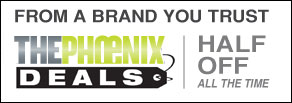All Blogs
- On The Download (3,072)
- PageViews (338)
- Phlog (1,956)
- Outside The Frame (535)
- Talking Politics (1,934)
- Laser Orgy (281)
- Dont Quote Me (583)
ADVERTISEMENT

 Filed Under: SXSW, MTV, SXSW11, Soulth by Southwest, Pepsi, MusicMetric, Music Discovery, BlueFin Labs, Echo Nest
Filed Under: SXSW, MTV, SXSW11, Soulth by Southwest, Pepsi, MusicMetric, Music Discovery, BlueFin Labs, Echo Nest
Related Articles

Jeff the Brotherhood bring the DIY
Published 3/25/2011 by LIZ PELLY
Elemental

SXSW Music 2011 Photos Day 3: Miami Horror, Orchestral Manoeuvres in the Dark, Surfer Blood, Trap Them
Published 3/25/2011 by JANICE CHECCHIO
Miami Horror, Orchestral Manoeuvres in the Dark, Surfer Blood, Trap Them | SXSW | March 16, 2011

more by Carly Carioli
Punk fucking rock: Bad Brains, Trash Talk, and Trap Them at SXSW [video] | March 23, 2011
Music Discovery: Tracking the top artists at SXSW 2011 | March 21, 2011
Video: Total anarchy erupts during Odd Future gig at the Fader Fort | March 18, 2011
SXSW 2011 (Wednesday): Dom, the Good Natured, Seedy Seeds, Young Adults, Girlfriends at Boston Phoenix's First Contact party [video] | March 17, 2011
SXSW Tuesday Recap: You Didn't Really Want To See The Foo Fighters Anyway | March 16, 2011
 See all articles by:
Carly Carioli
See all articles by:
Carly Carioli


OTD Categories
VIDEO: Arctic Monkeys at the House of Blues Rare Frequencies: Trouble and treble
Lady Lee's Lion's Den Playlist
HOMEWORK: Assignment #2: D-Tension
Ticket On-Sale Alert: Muse, Mariah Carey, Black Eyed...

Latest Comments
Meet the Mayor: Guitar Center -
Shattered-Glass-Audio, Don't they make those "Fµ(|{1n9 Rad" solid state guitar amps that...
By Todd Livingstone on 03-25-2011 in Phlog
Suspended In Time: The Phoenix Remembers Adam Aries - That was so great! Thanks so much for praising a man well worth the praise. He was a wonderful nephew...By Andrea Sevinsky on 03-25-2011 in Phlog
[phlipcam video] Cold War Kids @ House of Blues - Cheap jerseys,wholesale jerseys,cheap NFL Jerseys,Wholesale NHL Jerseys,MLB Jerseys,Cheap MLB Jerseys...By nfl2shop28 on 03-24-2011 in On The Download
Independent Film Festival of Boston 2011 - I live in the Gulf Coast region of Alabama and my wife and I are making the trip to Boston for this esteemed...By David Roffman on 03-23-2011 in Outside The Frame
Having sex in Fable 3 – and the trouble with love - Yes this was very well written and really funny haha. I can relate to your boyfriend though. Ill probably...By Keith on 03-23-2011 in Laser Orgy
 Latest Comments from On The Download
Latest Comments from On The Download

Most Viewed
Mr. Awesome
Phoenix book reviews in Powell's
WFNX Boston Accents playlist 02.27.11
Slaine to Appear on NBC's "The Cape" Tonight
[awesome video alert] Bodega Girls "School Night"
iTunes releases "The Hunger," new Shirley Manson track off Prometheus Bound
Rest In Peace Roc Dukati
 Most Viewed from On The Download
Most Viewed from On The Download

Links
Bradley’s Almanac - Lower Allston blogging and bootlegging since 2001
Band in Boston -
Basstown -
Wayne&Wax -
Aurgasm -
Onward Charles -
Compound 440r -
Anti-Gravity Bunny -
Clicky Clicky -
Soul Clap -
Lemmingtrail -
WMBR -
WFNX -
Beginning To See the Light -
Jump the Turnstyle -
Heads Up Boston -
Loaded Gun -
Enough Cowbell -
Vanyaland -
Ryan's Smashing Life -

On The Download Archives
TODAY'S FEATURED ADVERTISERS
thePhoenix.com
Phoenix Media/Communications Group
Copyright © 2011 The Phoenix Media/Communications Group



















 The good, the bad, and the indie: Boston may have broken Austin at this year's SXSW
The good, the bad, and the indie: Boston may have broken Austin at this year's SXSW
 The Big Hurt: Pancakes! Lent! Golf!
The Big Hurt: Pancakes! Lent! Golf!
 Chuck Turner is going to jail, but it's the Feds who should be hanging their heads in shame
Chuck Turner is going to jail, but it's the Feds who should be hanging their heads in shame
 Review: Strega Waterfront
Review: Strega Waterfront
 Massachusetts' crisis: learning a second language
Massachusetts' crisis: learning a second language
 Boston Ballet's Elo Experience
Boston Ballet's Elo Experience
 Review: Win Win
Review: Win Win
 Ron Sexsmith faces his doubts
Ron Sexsmith faces his doubts
 Review: Roxy's Gourmet Grilled Cheese
Review: Roxy's Gourmet Grilled Cheese
.jpg) Richard Ashcroft digs America
Richard Ashcroft digs America



